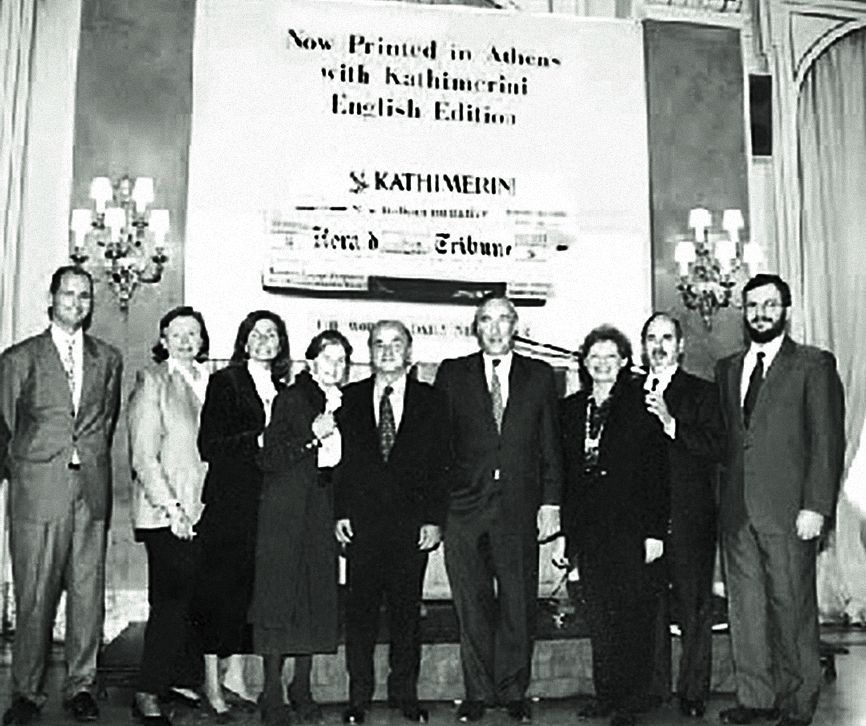
Kathimerini Greece Newsroom
Aristides Alafouzos, the late owner of Kathimerini, loved challenges. In 1988, a critical period for the Greek press, he bought Kathimerini, ensuring that the prestige and integrity of this historic newspaper would be preserved. Nine years later, he was contacted by the people of the Paris-based International Herald Tribune, who proposed a fresh challenge: a partnership between Kathimerini and the IHT (which was a joint venture between The New York Times and the Washington Post until the Times acquired full ownership in 2003) that would see the release of an English-language edition of the Greek newspaper. It was a groundbreaking initiative, a first in the Greek media landscape.
Alafouzos, who had established his good reputation in the competitive arena of international shipping, jumped at the opportunity. “I want us to be citizens of the world and the newspaper of the world,” he said describing the project which was early on supported by Martha Dertili, Alexis Papachelas, Alberto Cano and Nikos Konstandaras (who served as the first editor-in-chief of Kathimerini English Edition) on the side of Kathimerini, as well as by Didier Brun of the IHT and Stephen Dunbar-Johnson and Achilles Tsaltas of the NYT.
Indeed, on March 9, 1998, the English edition was up and running featuring content worthy of its premium international peers. Alafouzos was after all personally interested in the project and was constantly updated on its development as a small group of journalists put the dummy versions together.
It looked great. It could not have been otherwise given that Kathimerini English Edition was sold as an insert with the IHT in Greece and Cyprus. In a partnership with such media giants, any mistake, any misstep, any sloppiness would become painfully evident. The goal, therefore, was to convince readers from the start that the English-language edition had the gravitas to report on local developments with credibility and objectivity, free from partisan political influence and true to the ethical principles of independent journalism. The smooth partnership continued undisturbed when the IHT was rebranded as The International New York Times. This policy, which was followed inviolably for the next 25 years (celebrated last week), was vindicated over time.
“Kathimerini English Edition is appreciated internationally; it is the main source of news for foreign readers who want immediate, accurate and comprehensive coverage and analysis about developments in Greece, whether they are foreign government officials, international organization representatives, investors, influential players or just visitors,” says Tom Ellis, who has been the paper’s editor in chief since 2017. “The joint publication constitutes a natural partnership between two historic newspapers that share common values,” he adds. Stephen Dunbar-Johnson (r) with Helen Konstantopoulos, VP of International Circulation and Development at the NYT (l), and then Kathimerini board member Martha Dertili (c).
Stephen Dunbar-Johnson (r) with Helen Konstantopoulos, VP of International Circulation and Development at the NYT (l), and then Kathimerini board member Martha Dertili (c).
Helen Konstantopoulos, vice president of International Circulation and Development at the NYT, has been a warm supporter of the joint venture, playing a critical role in its success.
During those 25 years, Kathimerini English Edition has had to cover many landmark events including Greece’s adoption of the single currency, the Athens Olympic Games, the debt crisis, the Indignant Citizens movement, the fatigue with the Greek debt crisis, and the 2015 bailout referendum.
It was a very busy quarter of a century. Meanwhile, Greek public opinion was often out of line with the international consensus. During the NATO bombing of Yugoslavia in 1999, the English-language edition followed local opposition to the policy while the IHT held a different editorial line. On its 25th birthday, it is as clear as ever that this newspaper has a very meaningful role to serve. The editor in chief of Kathimerini English Edition, Tom Ellis (c), is seen during an editorial meeting.
The editor in chief of Kathimerini English Edition, Tom Ellis (c), is seen during an editorial meeting.































